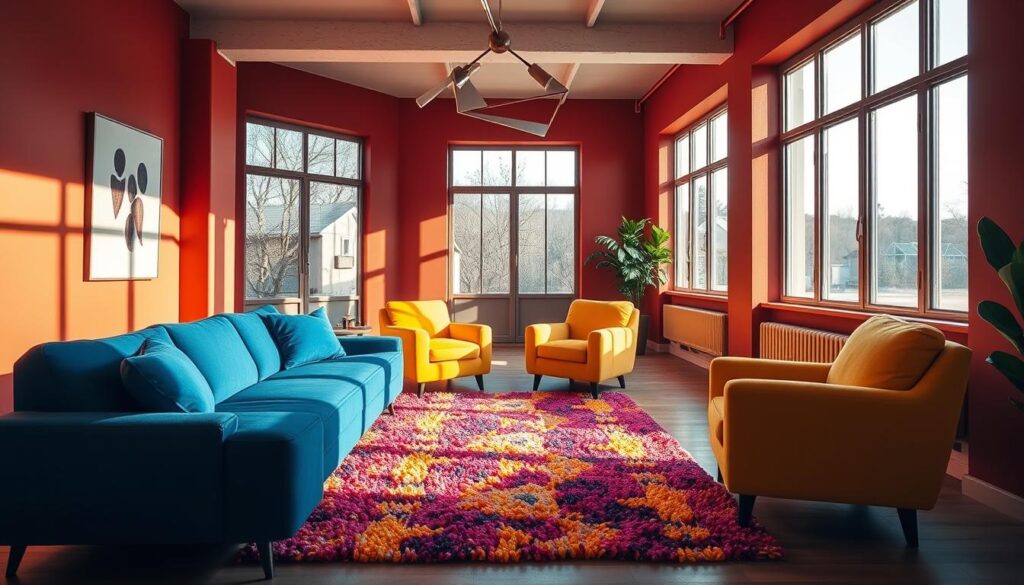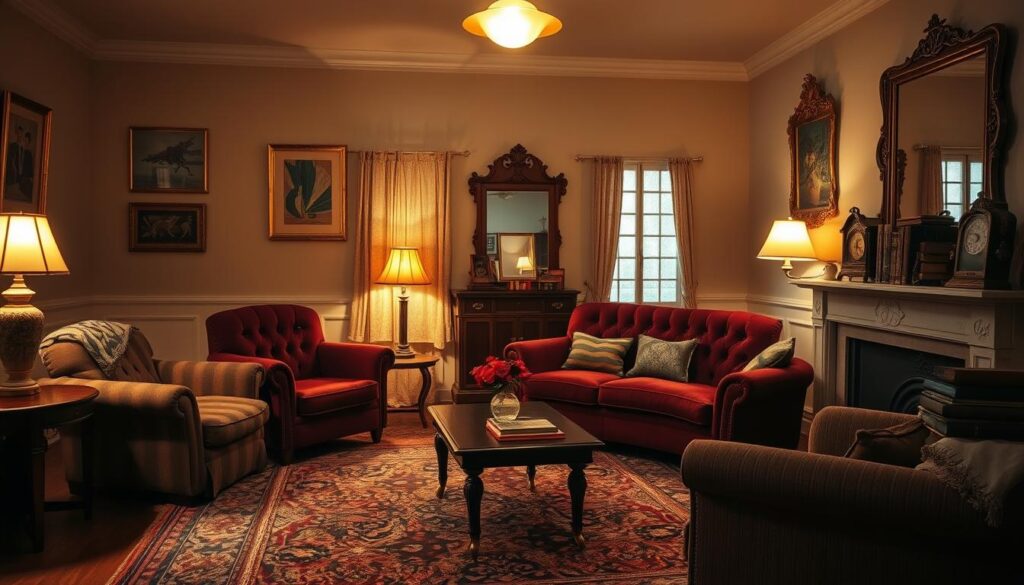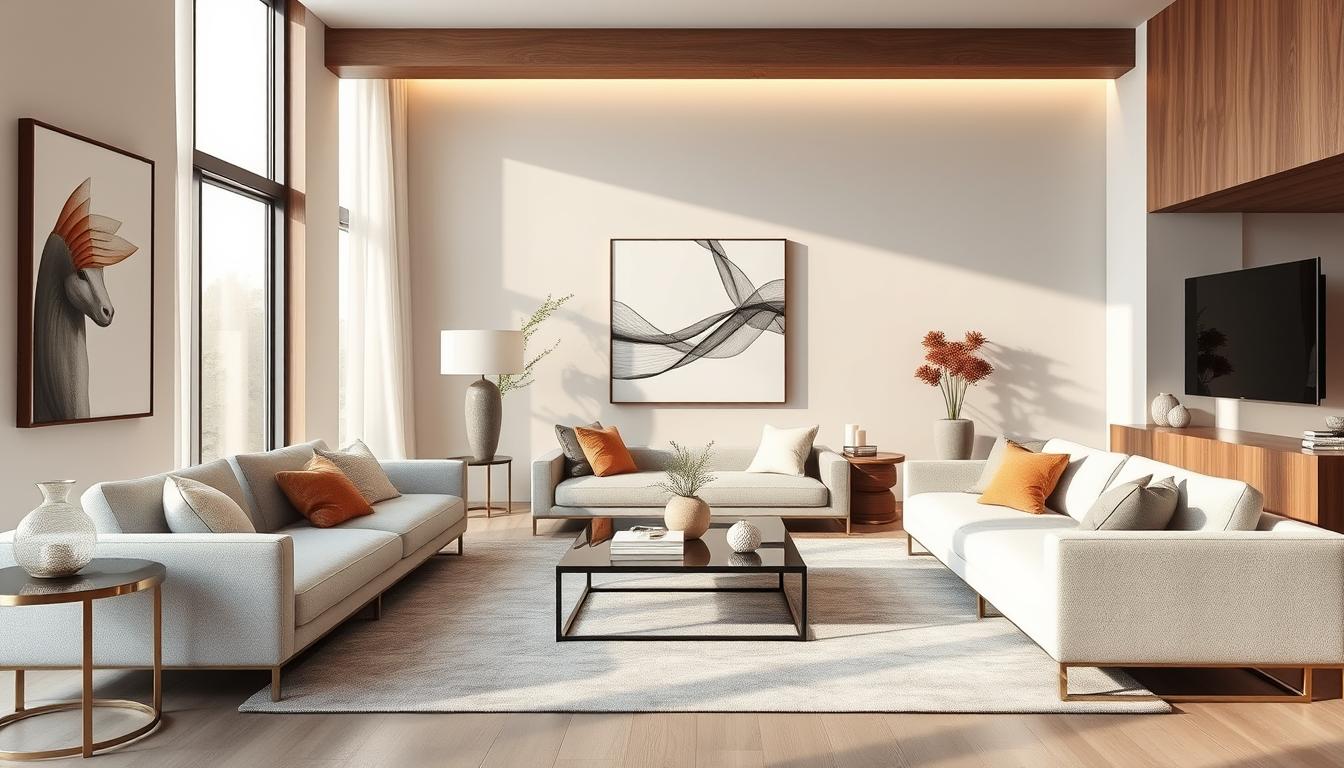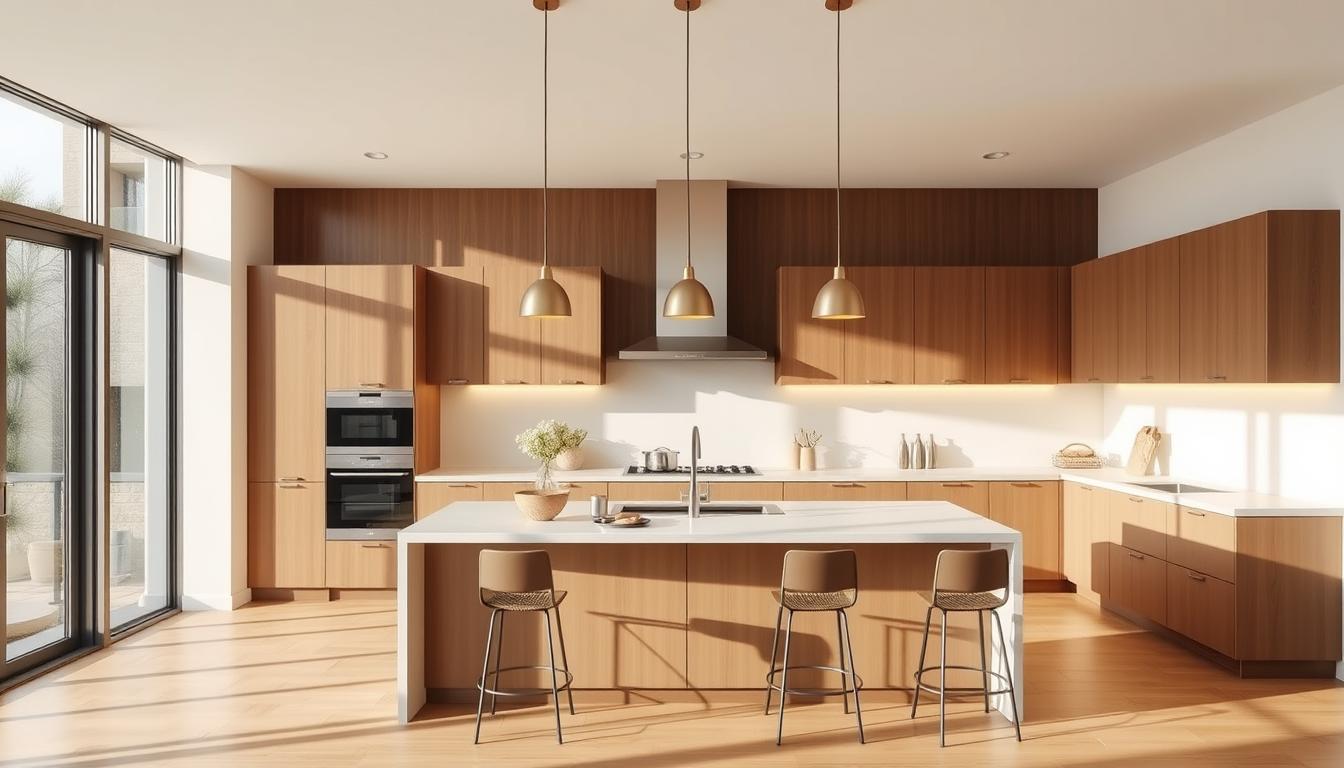As we enter 2023, the world of home decor is buzzing with new trends. These trends aim to refresh our living spaces. We’ve collected 35 home design and remodeling trends that everyone is looking forward to.
These trends include embracing nature with biophilic design and bold color choices. They promise to change how we see our homes. Our picks for 2023 showcase the most sought-after interior styles for the year.
Key Takeaways
- Biophilic design is a top trend for 2023
- Bold color choices are making a statement
- Modern home decor is all about embracing nature
- Popular interior styles are getting a fresh update
- 35 home design trends are exciting homeowners and pros
Embracing Nature with Biophilic Design
Biophilic design is changing how we see our homes, bringing nature inside. It connects us with the outdoors, making us feel better and more at peace.
Adding plants, natural materials, and lots of light makes our spaces look good and feel healthy.
Benefits of Incorporating Plants
Plants in our homes clean the air and make us happier and more productive. They are key in biophilic design, creating a calm and natural feel. Good plants for indoors include snake plants, spider plants, and peace lilies.
Natural Materials in Furniture
Using natural materials in furniture is important in biophilic design. Materials like reclaimed wood, bamboo, and stone add warmth and texture. For example, a wooden coffee table from sustainably sourced oak can bring nature into our living rooms.
Maximizing Natural Light
Getting as much natural light as possible is key in biophilic design. It cuts down on the need for artificial light and connects us to the outdoors. We can get more light by using sheer curtains, installing skylights, or moving our furniture to clear the way.
| Element | Benefits | Examples |
|---|---|---|
| Plants | Air purification, mood boost | Snake plants, spider plants |
| Natural Materials | Warmth, texture, sustainability | Reclaimed wood, bamboo, stone |
| Natural Light | Reduced artificial lighting, enhanced outdoor connection | Sheer curtains, skylights |
By using biophilic design, we can make our homes not just trendy but also healthier. Choosing colors like greens and earthy tones can make our spaces feel more natural.
Sustainable and Eco-Friendly Designs
In 2023, we see a big change towards green home designs. This change shows our growing care for the planet. People want homes that look good and are good for the environment.
Home design is changing, making sustainability key. We want homes that look great and are kind to our planet. This is a big shift towards better home styles.
Upcycled Furniture Options
Upcycling is a big part of green design. It turns old stuff into new, cool furniture. For example, old pallets can become coffee tables, and old doors can be headboards.
“The most alarming sign of the times is not that we are destroying the natural world, but that we are destroying the world that we have created.” –
Upcycling is creative and helps the planet. Here are some cool upcycled furniture ideas:
- Reclaimed wood furniture
- Old ladder shelving
- Converted industrial pieces
Energy-Efficient Appliances and Features
Green furniture is just part of the story. Energy-saving appliances are also key. They use less energy and save money on bills.
Here are some energy-saving features to think about:
| Feature | Description | Benefits |
|---|---|---|
| LED Lighting | High-efficiency lighting that uses significantly less energy | Reduces energy consumption, longer lifespan |
| Smart Thermostats | Automated temperature control for optimal heating and cooling | Energy savings, increased comfort |
| Energy Star Appliances | Appliances that meet energy efficiency standards set by the U.S. Environmental Protection Agency | Lower utility bills, reduced environmental impact |
By using these green design elements, homes can be both stylish and eco-friendly. As we keep moving towards green design, our homes will become more sustainable. This will shape the future of home decor.
Minimalism: Less is More
Minimalism is a timeless trend in interior design. It focuses on the beauty of simplicity. It’s not just about getting rid of clutter. It’s about making a space that feels calm, functional, and simple.
At its heart, minimalism values simplicity and functionality. It’s about choosing clean lines, uncluttered spaces, and simple colors. By choosing minimalism, you can make a space that looks good and feels calm.
Functional Furniture Choices
Choosing the right furniture is key in minimalist design. It’s about picking pieces that do more than one thing. For example, a storage ottoman can be both a seat and a place to store things. This shows the minimalist idea of doing more with less.
- Opt for multi-functional furniture pieces.
- Select furniture with clean lines and simple designs.
- Avoid overly ornate or complicated furniture designs.
For more ideas on making your space minimalist, check out our top 10 interior home decor ideas at https://kaiaruang.com/our-top-10-interior-home-decor-ideas-to-transform-your-space/.
Creating Open Spaces
Creating open spaces is vital in minimalist design. It’s not just about the layout but also how the space feels. By removing barriers and using light dividers, you can make a space feel open and flowing.
- Minimize the use of heavy curtains or drapes.
- Use mirrors strategically to enhance the sense of space.
- Maintain a clutter-free environment to preserve the openness.
Bold Color Choices for a Daring Look
This year, we’re seeing a big change in home decor. Gone are the days of minimalism. Now, bold colors are taking center stage in 2023.

Bold colors can change a room’s vibe, giving it a unique feel. To make bold colors work, pair them with neutral tones. This creates a space that looks good and feels right.
Trending Color Palettes
The newest color schemes are all about deep, rich hues. These colors add depth and character to any room. Some popular palettes include:
- Deep blues and emerald greens for a luxurious feel.
- Warm terracottas and sun-kissed yellows for a cozy vibe.
- Bold reds and oranges for energy and vibrancy.
Accents and Accessories in Bold Hues
Adding bold colors to your decor is easy with accents and accessories. Think throw pillows, blankets, vases, and more. These items can make a room pop with color.
For example, bold throw pillows on a neutral sofa can make a big impact. Or, bold-colored vases can add a splash of color and tie the room together.
The Rise of Smart Home Technology
Smart home technology is changing how we live. It makes our homes more efficient and easy to use. This tech is a key part of innovative home design trends and contemporary design ideas.
Smart home tech includes many devices and systems. These help make our homes better places to live. They range from voice-controlled assistants to automated lights and temperature control.
Integrated Technology Solutions
Smart home tech is great because it connects different systems. This makes controlling our homes easier and more enjoyable. For example, you can manage lights, security, and entertainment with one system.
- Centralized control systems for ease of use
- Enhanced security features through smart locks and cameras
- Energy efficiency through automated lighting and thermostat control
Smart Lighting and Thermostats
Smart lighting and thermostats are very popular. They make our lives easier and help save energy. Smart lights adjust based on time or if you’re home. Thermostats learn your temperature likes and adjust automatically.
| Feature | Smart Lighting | Smart Thermostats |
|---|---|---|
| Energy Efficiency | Automated lighting control reduces energy waste | Optimizes heating and cooling based on occupancy and preferences |
| Convenience | Can be controlled remotely or programmed | Adjusts temperature settings automatically |
| Customization | Offers various lighting scenes and moods | Learns and adapts to your temperature preferences |
In conclusion, smart home technology is a big deal in home design. It makes our homes better by using tech like smart lights and thermostats. As we look at contemporary design ideas, smart home tech will be key in shaping our homes’ future.
Vintage and Retro Revival
Vintage and retro revival is more than a trend. It’s a way to add character and depth to our homes. This movement is about embracing the past and mixing it with our modern lives.
When we add vintage and retro elements, we’re not just decorating. We’re telling stories through the pieces we choose. These can range from antique furniture to retro-inspired accessories, each with its own history and charm.
Furniture and Decor from the Past
Furniture and decor from past decades are being rediscovered in our homes. Vintage armchairs, antique tables, and retro-patterned rugs create a nostalgic atmosphere.
Some popular vintage and retro pieces include:
- Mid-century modern furniture, known for its clean lines and organic shapes.
- Retro-colored appliances and kitchenware, adding a pop of color to our kitchens.
- Antique lighting fixtures, which can become statement pieces in any room.
When choosing vintage or retro pieces, think about their condition, era, and how they fit with your decor.
Mixing Vintage with Modern Elements
The key to successfully incorporating vintage and retro elements is balancing them with modern pieces. This blend creates a visually interesting and layered look.
For example, pairing a vintage sofa with a modern coffee table or combining retro-patterned wallpaper with contemporary furniture can create a unique and stylish space.
Here’s a simple guide to mixing vintage and modern elements:
| Element | Vintage/Retro | Modern |
|---|---|---|
| Furniture | Vintage armchair | Modern sofa |
| Lighting | Antique chandelier | Modern table lamp |
| Decor | Retro posters | Contemporary art pieces |
As
“The way to get started is to quit talking and begin doing.”
, we can apply this to our decorating journey by starting with small, meaningful pieces that reflect our personal style.
By mixing vintage and retro elements with modern pieces, we can create a home that is not only stylish but also rich in character and history.

Multi-Functional Spaces
Home design is changing, and multi-functional spaces are key. We need our living areas to be flexible. This is why multi-functional design is becoming more common.
Our homes are now used in different ways. Areas serve more than one purpose. This change is because our lifestyles are always evolving.
Designing for Versatility
Creating versatile spaces means they can change easily. For example, a home office can also be a guest room. Or a living area can turn into a play space for kids.
To make spaces versatile, we use various design elements. These include:
- Modular furniture that can be rearranged or repurposed
- Multi-functional decor items that serve more than one purpose
- Flexible lighting solutions that can be adjusted based on the activity
Furniture that Adapts to Needs
Furniture is essential for multi-functional spaces. We need pieces that look good and work well. They should also be able to change as our needs do.
Adaptive furniture includes:
| Furniture Type | Primary Function | Secondary Function |
|---|---|---|
| Sofa Bed | Seating | Guest Bed |
| Storage Ottoman | Footrest | Storage Unit |
| Drop-Leaf Table | Dining Table | Workspace/Console Table |
By adding such furniture, our homes become both beautiful and practical. They adapt to our changing needs.
The trend of multi-functional spaces will keep growing. This is because we always need our homes to be flexible and efficient.
Warm, Cozy Textures
Warm and cozy textures are adding depth and comfort to our homes. They make our living spaces welcoming. By mixing different textures, we can make our homes cozy and inviting.
Layering Soft Fabrics
Layering soft fabrics makes our homes warm and cozy. We can use throw blankets, rugs, and pillows in soft materials. For example, a faux fur throw on a cotton sofa adds luxury.
Some popular soft fabrics for layering include:
- Velvet
- Faux fur
- Cable knit
- Soft cotton
Introduce Warmth with Textiles
Textiles bring warmth to our living spaces. Choosing natural, earthy tones creates a cozy atmosphere. For instance, a warm-toned rug adds warmth and texture.
Here are ways to introduce warmth with textiles:
- Using throw blankets in warm, earthy tones
- Incorporating natural fiber rugs
- Adding pillows in soft, chunky materials
Personalized Spaces Reflecting Individuality
Personalized spaces show our stories, experiences, and who we are. Making our homes truly ours is very important. It’s how we evolve in our living environments.
Creating a space that shows our individuality is more than picking furniture and decor. It’s about choosing elements that tell our story. This can be done through customization in decor, where every piece tells a part of our life.
Customization in Decor
Customization lets us add our personality to our homes. From contemporary design ideas to stylish home furnishings, the choices are vast. It’s about finding the right mix of looks and function.
Adding family heirlooms or personal treasures to our decor adds depth and meaning. Choosing stylish home furnishings that match our style can make our home truly reflect us.
Reflecting Personal Stories and Experiences
Our homes hold our memories and experiences. Using decor to reflect our stories makes our spaces more intimate and meaningful. This can be done by displaying personal items like travel souvenirs or family photos.
Our decor choices can also show our values and dreams. For example, using eco-friendly elements shows we care about the environment. By curating our spaces thoughtfully, we create homes that are beautiful and meaningful.
In conclusion, personalized spaces are a powerful way to make our homes truly ours. By embracing customization and reflecting our personal stories, we can create homes that are not only beautiful but also deeply meaningful.
Open Concept Living: A Timeless Trend
Open concept living is a timeless choice that brings a sense of openness and flow. It’s a key part of modern home decor and remains popular. Its benefits are many.
Open concept living does more than just look good. It makes our homes more livable. By removing walls, we get a bigger, airier space that’s perfect for today’s living.
Benefits of Open Layouts
Open concept living gives us a sense of freedom. Without walls, we can move around easily and connect with others better.
- Increased natural light circulation
- Improved social interaction
- A more spacious feel
Open layouts are also super flexible. They can change to fit different needs and activities. This is great for modern homes where work and play blend together.
Creating Seamless Transitions
To get the most from open concept living, we need to make transitions smooth. This requires careful planning and design.
| Design Element | Purpose | Tips |
|---|---|---|
| Consistent Flooring | Creates a sense of continuity | Choose materials that are durable and visually appealing |
| Color Scheme | Unifies the space | Select a palette that complements different areas |
| Lighting | Enhances ambiance and functionality | Use a mix of overhead, task, and accent lighting |
By using these design elements, we can make a living space that’s both beautiful and functional. It will reflect our personal style and meet our needs.
In conclusion, open concept living is a trend that keeps evolving with our lifestyles. Understanding its benefits and using smart design can make our homes beautiful, functional, and welcoming.
Integrating Art into Interior Spaces
Incorporating art into our homes is a timeless trend. It adds personality and depth. Artwork makes our spaces unique and shows off our style.
The Role of Artwork
Artwork can make our homes look better and spark interesting conversations. By picking pieces we love, we create a welcoming space. It shows off our personal taste.
When adding art, think about its style and how it fits with our decor. This careful choice helps balance our furniture, colors, and art. It makes our space feel like our own.



